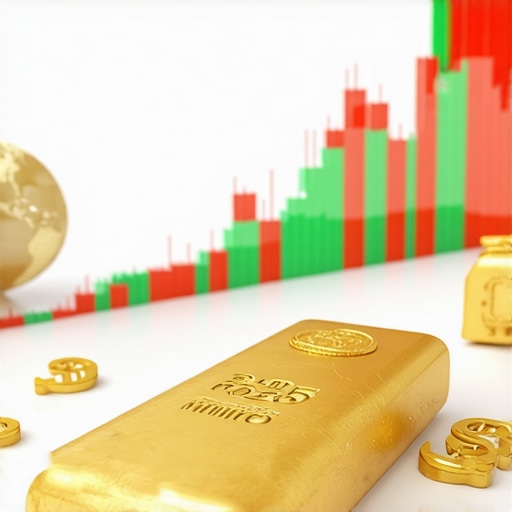Unearthing the Pulse: Why Emerging Markets Are Shaping Gold Demand in 2025
The global gold market is witnessing a dynamic transformation, significantly driven by emerging economies whose growing middle classes, evolving financial habits, and cultural affinity for gold are reshaping demand trends. Understanding gold demand trends in emerging markets 2025 is crucial for investors and market analysts alike, offering a window into not only consumption patterns but also economic resilience and geopolitical influences.
Gold’s Cultural Resonance and Economic Growth: The Dual Engines
Emerging markets such as India, China, and Southeast Asia retain a deep-rooted cultural reverence for gold, often seen as a symbol of wealth and security. This cultural affinity, combined with robust economic growth rates projected for 2025, is amplifying demand, especially in jewelry and investment segments. For example, India’s gold consumption during festival seasons and weddings remains a significant driver, with forecasts suggesting increased purchases fueled by rising disposable incomes and urbanization.
How Do Inflation and Currency Fluctuations Influence Gold Demand in These Markets?
Inflationary pressures and currency volatility in emerging economies often propel investors toward gold as a hedge against financial uncertainty. In countries where fiat currencies face depreciation risks, gold serves as a reliable store of value. This trend intensified post-pandemic, where central bank policies and geopolitical tensions have heightened economic unpredictability. An illustrative case is Turkey, where local investors increased gold buying substantially amid lira depreciation. Understanding these macroeconomic factors allows a nuanced appreciation of gold demand beyond mere cultural consumption.
Investment Vehicles and Accessibility: Democratizing Gold Ownership
Emerging markets are witnessing a surge in gold investment through diversified instruments—physical gold bars, coins, and increasingly, financial products like gold ETFs and mutual funds. The accessibility of digital platforms enabling fractional gold ownership is crucial in democratizing investment, particularly among younger demographics. This trend aligns with global shifts toward portfolio diversification strategies that hedge against inflation and market volatility. Insights into these evolving investment preferences are vital for crafting responsive market strategies.
Supply Chain Dynamics: Meeting the Rising Appetite
Meeting the burgeoning gold demand in emerging markets presents challenges and opportunities related to supply chain logistics, import regulations, and price sensitivities. The interplay between local demand spikes and global supply constraints often results in premium pricing and increased market volatility. Investors and policymakers must navigate these complexities, balancing supply sustainability with demand-driven growth. Detailed market analysis, such as those found in comprehensive gold supply and demand studies, offers critical insights into these dynamics.
Engage with Us: What Are Your Perspectives on Emerging Market Gold Trends?
We invite readers to share their experiences and predictions regarding gold demand in emerging economies. How do you see these trends influencing your investment decisions or economic outlook? Join the conversation, share this article, and explore further resources to deepen your understanding of global gold markets.
For authoritative insights into global economic conditions influencing gold demand, consult the World Gold Council’s detailed reports, a leading source for market data and analysis.
Bridging Tradition and Innovation: Gold’s Role in Modern Emerging Markets
From my experience observing gold markets over the years, what fascinates me most is how emerging economies blend their rich cultural heritage with cutting-edge financial innovations. For instance, I recently spoke to a young investor in Mumbai who told me how she prefers gold ETFs over physical gold, appreciating the ease of digital transactions but still cherishing gold’s traditional value. This shift towards digital gold investment platforms is not just a trend but a reflection of how accessibility is reshaping demand patterns.
This democratization of gold ownership is further supported by technological advances that allow smaller investment amounts—a game changer for middle-class investors who might have found physical gold bars prohibitively expensive before. It’s like watching history and future collide in the same investment choice.
Regulatory Landscapes and Their Impact on Gold Demand
On the flip side, my encounters with local dealers and investors in Southeast Asia often reveal how regulations can either facilitate or hinder gold trade. Import duties, taxation policies, and certification requirements vary widely, affecting market pricing and investor confidence. For example, Indonesia’s recent adjustment in import tariffs caused noticeable ripples in local gold prices and buying behaviors.
Understanding these regulatory nuances is crucial for investors looking to tap into emerging markets. They can mean the difference between a smooth transaction and unexpected costs or delays. It reminds me how investing in gold isn’t just about price forecasts or cultural factors but also about navigating complex policy environments effectively.
How Can Investors Balance Cultural Traditions with Modern Investment Strategies in Emerging Markets?
That question often pops up in my conversations with both novice and seasoned investors. Balancing the emotional and cultural attachment to physical gold with the practical benefits of financial products like ETFs or mutual funds can be challenging. One approach I find effective is diversifying within gold investments—holding some physical coins or jewelry for sentimental and cultural value while allocating a portion to ETFs for liquidity and ease of management.
Resources like the guide for beginners on building a gold portfolio provide excellent frameworks for this balance, helping investors tailor strategies that respect cultural preferences while optimizing financial outcomes.
Monitoring Global Influences: Central Banks and Market Signals
Another layer to consider is the role of central banks in emerging economies. Their gold purchasing policies can signal confidence or caution to the markets. During my recent research, I came across reports by the World Gold Council highlighting how increased central bank gold acquisitions often precede shifts in market trends, impacting prices globally.
These insights emphasize the interconnectedness of global and local factors shaping gold demand. For investors paying close attention, such signals can offer early warnings or opportunities. It’s like reading the pulse of the market through multiple lenses.
Let’s Keep the Conversation Going!
Have you noticed these shifts in gold investment preferences in your region or network? How do you personally balance the allure of physical gold with the conveniences of ETFs or mutual funds? Share your stories and questions below; your experiences enrich this ongoing dialogue. And if you’re curious to dive deeper into the nuances of gold demand trends and investment strategies, check out our other insightful articles like gold price forecasts and market preparation tips or exploring supply and demand trends for smarter investing. Let’s navigate this golden journey together!
Decoding Complex Regulatory Frameworks: Navigating Gold Market Barriers with Precision
Emerging markets present a labyrinth of regulatory frameworks that profoundly influence gold demand dynamics. Beyond the surface-level import tariffs and tax codes lies a complex web of compliance standards, anti-money laundering regulations, and certification requirements that shape market accessibility. For instance, Southeast Asia’s diverse regulatory landscape necessitates a granular understanding to optimize investment timing and method. Investors must stay abreast of these evolving policies, as abrupt changes can trigger ripple effects across pricing and liquidity.
One advanced tactic involves leveraging local partnerships to navigate bureaucratic nuances effectively, reducing transaction friction and mitigating compliance risks. Moreover, understanding how governments balance gold import restrictions with their foreign exchange reserves strategy can provide foresight into future market movements. For proactive investors, integrating regulatory intelligence into their decision matrix is no longer optional but essential.
What Are the Sophisticated Hedging Techniques for Gold Investors Facing Currency Volatility in Emerging Markets?
Currency volatility remains a formidable challenge in emerging economies, often complicating gold investment returns. Advanced investors employ multi-layered hedging strategies that combine gold holdings with derivative instruments such as currency futures and options. This approach allows for risk mitigation against both local currency depreciation and gold price fluctuations simultaneously.
Additionally, some seasoned market participants utilize cross-asset hedging by integrating commodities and foreign equities to diversify exposure. These strategies require deep market insight and access to sophisticated financial instruments, often provided by international brokers specializing in emerging market assets. Understanding these methods empowers investors to protect capital and optimize returns in volatile environments.
Integrating Technological Innovations: Blockchain and Digital Gold Ownership Revolution
The advent of blockchain technology is catalyzing a paradigm shift in how gold ownership and transactions are recorded and verified. Tokenized gold on blockchain platforms offers unparalleled transparency, security, and liquidity, addressing longstanding challenges in physical gold custody and authentication.
Such innovations enable fractional ownership with real-time settlement, broadening access for retail investors and institutional players alike. For emerging markets, where trust and verification can be impediments, blockchain solutions are proving transformative by lowering entry barriers and enhancing market confidence. This intersection of tradition and technology exemplifies the future trajectory of gold investment, blending cultural reverence with financial innovation.
As the World Gold Council highlights in their recent Digital Gold Market Report 2024, these developments signal a significant evolution in gold demand patterns, particularly in digitally savvy emerging economies.

Strategic Insights: How Can Investors Leverage Data Analytics to Forecast Gold Demand in Emerging Markets?
Harnessing big data and predictive analytics offers investors a competitive edge in anticipating gold demand fluctuations. By analyzing variables such as consumer sentiment, import-export data, macroeconomic indicators, and social media trends, sophisticated models can predict spikes or dips in demand with higher accuracy.
Machine learning algorithms, for example, can identify subtle correlations between geopolitical events and gold purchasing behaviors that traditional analysis might overlook. This data-driven approach facilitates timely portfolio adjustments, risk management, and opportunity identification. For investors aiming to stay ahead in the dynamic emerging market landscape, integrating analytics tools is becoming indispensable.
Exploring these advanced methodologies can transform how gold demand trends are interpreted and acted upon, moving beyond intuition to evidence-based strategies.
Join the Expert Dialogue: Elevate Your Gold Investment Acumen
Are you ready to deepen your understanding of gold’s evolving role in emerging markets? Engage with our expert analyses and community discussions to explore nuanced strategies that blend cultural insights, regulatory savvy, and cutting-edge technology. Share your experiences or pose queries about complex investment scenarios to enrich this collaborative knowledge base.
Delve into our curated resources and upcoming webinars designed to equip you with the tools necessary for mastering gold demand trends in 2025 and beyond.
Harnessing Regulatory Intelligence: A Tactical Edge for Gold Investors
In the intricate tapestry of emerging gold markets, regulatory frameworks extend beyond mere compliance checkpoints; they are pivotal levers influencing supply, pricing, and investor sentiment. Astute investors develop comprehensive regulatory intelligence systems, incorporating real-time policy monitoring and local stakeholder engagement to anticipate shifts in import tariffs, certification protocols, and taxation regimes. This proactive stance mitigates transactional risks and uncovers arbitrage opportunities often concealed within bureaucratic labyrinths.
What Advanced Hedging Mechanisms Can Investors Employ to Counter Currency and Market Volatility in Emerging Economies?
Addressing currency volatility requires sophistication beyond traditional hedges. Leading practitioners integrate multi-asset hedging strategies—combining gold holdings with currency derivatives like forwards, options, and swaps—to create dynamic risk-neutral positions. Additionally, cross-hedging with correlated commodities or equities enhances portfolio resilience. These layered approaches demand granular market analytics and access to international financial instruments, frequently facilitated by specialized brokers with deep emerging market expertise.
Blockchain-Enabled Transparency: Revolutionizing Gold Ownership and Trust
The intersection of blockchain technology and gold investment is rewriting paradigms of ownership verification, liquidity, and transaction speed. Tokenized gold platforms utilize distributed ledgers to provide immutable proof of custody and provenance, drastically reducing counterparty risks endemic in physical markets. For emerging economies, where trust deficits and verification challenges persist, these digital innovations democratize access and bolster confidence among retail and institutional investors alike.
According to the World Gold Council’s Digital Gold Market Report 2024, adoption of blockchain-based gold investment vehicles is accelerating, particularly in digitally mature emerging markets, signaling a tectonic shift in demand modalities.

Leveraging Predictive Analytics: Forecasting Gold Demand with Machine Learning
Emerging markets present a rich data environment where machine learning algorithms can discern subtle patterns linking macroeconomic indicators, geopolitical events, and consumer sentiment to gold demand fluctuations. Advanced models utilize natural language processing on social media and news feeds, alongside quantitative trade and price data, to generate high-fidelity forecasts. These insights empower investors to anticipate demand surges or contractions with unprecedented accuracy, facilitating agile portfolio rebalancing and risk mitigation strategies.
Join the Vanguard: Elevate Your Gold Investment Strategy
Are you prepared to integrate these advanced strategies into your gold investment approach? Engage with our expert community to exchange insights, refine your hedging tactics, and explore blockchain-enabled investment opportunities. Subscribe to our in-depth analyses and participate in upcoming webinars tailored to empower investors navigating emerging market complexities. Embrace the future of gold investment with informed precision and strategic agility.
Frequently Asked Questions (FAQ)
What factors are driving increased gold demand in emerging markets in 2025?
Gold demand in emerging markets is propelled by a combination of cultural traditions valuing gold as a symbol of wealth, rising disposable incomes amid economic growth, inflation hedging needs due to currency volatility, and expanding access to gold investment vehicles such as ETFs and digital platforms. These factors collectively amplify consumption and investment interest in gold.
How do inflation and currency fluctuations affect gold investment decisions in these regions?
Inflation erodes purchasing power and currency depreciation increases financial uncertainty, prompting investors in emerging economies to seek gold as a reliable store of value and hedge. Gold often appreciates or maintains value when local fiat currencies weaken, making it a strategic asset during economic instability.
What role do technological innovations like blockchain play in modern gold ownership?
Blockchain technology introduces transparency, security, and liquidity to gold ownership by enabling tokenized gold platforms that provide immutable proof of custody, fractional ownership, and real-time settlement. This reduces counterparty risks and democratizes access, particularly benefiting digitally savvy investors in emerging markets.
How can investors balance cultural affinity for physical gold with modern financial products?
A balanced approach involves diversifying gold holdings by maintaining some physical gold for cultural and sentimental value while allocating a portion to ETFs or mutual funds for liquidity and easier portfolio management. This strategy respects tradition while optimizing investment efficiency.
What are the regulatory challenges investors face in emerging market gold trade?
Investors encounter diverse regulatory frameworks including import tariffs, taxation policies, certification requirements, and anti-money laundering laws. These can affect pricing, liquidity, and transaction complexity. Staying informed and leveraging local partnerships can help navigate these challenges effectively.
Which advanced hedging strategies help investors mitigate currency and market volatility?
Advanced investors use multi-asset hedging that combines gold holdings with currency derivatives like futures, options, and swaps, as well as cross-hedging with correlated commodities or equities. These layered strategies require sophisticated market insight and access to specialized financial instruments.
How can data analytics improve forecasting of gold demand in emerging markets?
Big data and machine learning enable analysis of macroeconomic indicators, geopolitical events, social media sentiment, and trade data to identify patterns and predict demand fluctuations. This empowers investors with timely insights for portfolio adjustment and risk management.
What impact do central bank gold purchases have on emerging market demand?
Central bank acquisitions often signal confidence or caution in the local economy, influencing investor sentiment and market trends globally. Increased buying by central banks can drive prices up and indicate strategic reserve diversification, serving as important market signals.
Why is democratization of gold investment important in emerging markets?
Democratization through fractional ownership and digital platforms lowers barriers to entry, enabling middle-class and younger investors to participate in gold markets. This broadens demand and fosters financial inclusion, aligning with evolving investment preferences in these regions.
How does supply chain complexity affect gold pricing and availability?
Supply chain issues, including import restrictions, logistics challenges, and global supply constraints, can lead to premium pricing and volatility. Efficient supply management and policy navigation are critical to meeting rising demand sustainably.
Trusted External Sources
- World Gold Council (WGC): As the premier authority on gold market data and research, WGC offers comprehensive insights into global gold demand trends, technological innovation impacts, and central bank activities, essential for understanding emerging market dynamics.
- International Monetary Fund (IMF): Provides macroeconomic data and analysis on emerging economies, including inflation and currency stability reports that directly influence gold investment behavior.
- Financial Action Task Force (FATF): Offers critical guidance on regulatory frameworks, anti-money laundering policies, and compliance standards relevant to cross-border gold trade in emerging markets.
- Bloomberg Intelligence: Delivers advanced analytics and market intelligence on commodities, including predictive models and hedging strategy insights, supporting data-driven investment decisions.
- MIT Digital Currency Initiative: Conducts pioneering research on blockchain technology applications in asset tokenization, underpinning the evolving digital gold ownership landscape.
Conclusion: Navigating Gold Demand Trends in Emerging Markets with Expertise and Innovation
The evolving gold demand landscape in emerging markets for 2025 is shaped by an intricate interplay of cultural reverence, economic growth, inflation hedging, regulatory complexity, and technological advancement. Investors who integrate these multidimensional insights—balancing tradition with modern investment instruments, leveraging regulatory intelligence, and harnessing predictive analytics—position themselves to capitalize on dynamic opportunities while mitigating risks inherent in volatile environments.
Blockchain-enabled transparency and democratized access are revolutionizing gold ownership, especially among younger, digitally native demographics, marking a transformative chapter in gold investment. Meanwhile, sophisticated hedging and data-driven forecasting equip investors to navigate currency and market fluctuations effectively.
By deepening your understanding of these trends and engaging with expert communities and resources, you can confidently craft strategies attuned to the unique challenges and prospects of emerging markets. Share your perspectives, explore further expert content, and apply these insights to elevate your gold investment acumen in 2025 and beyond.











This deep dive into the trends shaping gold demand in emerging markets for 2025 really resonates with what I’ve observed personally. In my recent experience working with investors in Southeast Asia, there’s a clear shift towards integrating digital gold platforms and ETFs, especially among younger demographics who are more comfortable with technological advancements. What I find particularly interesting is the balancing act between traditional cultural valuation of physical gold and the modern convenience of digital ownership. It seems this hybrid approach offers both emotional security and liquidity, which is crucial in volatile markets. I wonder, based on your insights, how do you see regulatory changes impacting this balance? Are there specific regions where regulatory hurdles are expected to slow down the digital transformation in gold investment? Understanding these dynamics is vital, as they could significantly influence investment strategies moving into the latter half of 2025.
This article offers a comprehensive and insightful overview of the evolving gold demand in emerging markets as we approach 2025. I’ve noticed firsthand how newer generations in countries like India and Southeast Asia are increasingly leaning toward digital gold and ETFs, blending traditional cultural values with modern technology. However, one challenge I foresee is the regulatory environment, which can vary significantly across regions. For example, some countries are still developing frameworks for tokenized gold which could either accelerate or hinder growth depending on policy changes. My question is: how do you think regulators can better balance fostering innovation while ensuring investor protection, especially in less mature markets? It would also be interesting to understand how geopolitical tensions might influence these regulatory shifts and the broader demand for gold. Overall, staying adaptable and keeping a close eye on policy evolution seems essential for investors navigating this dynamic landscape.